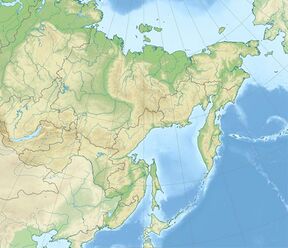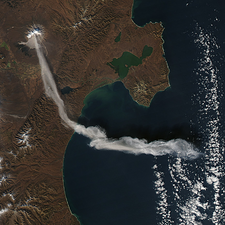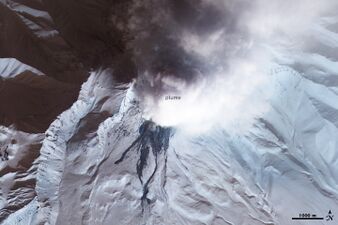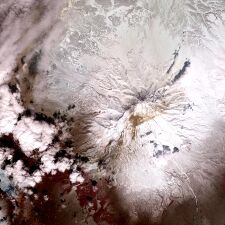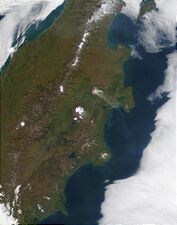Earth:Shiveluch
| Shiveluch | |
|---|---|
 Shiveluch from space (July 2007) | |
| Highest point | |
| Elevation | 3,283 m (10,771 ft) [1] |
| Prominence | 3,168 m (10,394 ft) [2] Ranked 73rd |
| Listing | Ultra |
| Coordinates | [ ⚑ ] : 56°39′12″N 161°21′42″E / 56.65333°N 161.36167°E [2] |
| Geography | |
| Location | Kamchatka, Russia |
| Parent range | Eastern Range |
| Geology | |
| Age of rock | Late Pleistocene[3] |
| Mountain type | Stratovolcano (active) |
| Last eruption | 1999 to 2023 (ongoing, non-stop)[4] |
| Climbing | |
| Easiest route | basic rock/snow climb |
Shiveluch (Russian: Шивелуч), also called Sheveluch, which originates from the name "suelich" which means "smoking mountain" in Itelmen[5] is the northernmost active volcano in Kamchatka Krai, Russia. It and Karymsky are Kamchatka's largest, most active and most continuously erupting volcanoes, as well as one of the most active on the planet. Shiveluch erupts around 0.015 km3 (0.0036 cu mi) of magma per year, which causes frequent and large hot avalanches and lava dome formations at the summit.[6] Volcanic ash emissions from this volcano often disrupt air traffic connecting the Asian and North American continents.
Geography
Shiveluch belongs to the Kliuchevskaya volcano group, located in central Kamchatka 84 kilometers (52 mi) northwest of Ust-Kamchatsk.[7] The nearest settlement from the volcano is Klyuchi, situated 50 km (31 mi) from the mountain.[8] The settlement is small enough to evacuate rapidly in case of a major eruption.[7]
Geologic setting
Shiveluch is a volcano within the Kuril–Kamchatka volcanic arc which hosts tens of other volcanoes. As the Pacific Plate crust subducts deeper under the Okhotsk Plate, the melting points of minerals underground are reduced by other materials including water which results in the materials melting and forming into magma which rises onto the surface and forms the volcanoes.
Structure
There are three elements of the volcano: the stratovolcano Old Shiveluch (Старый Шивелуч); an ancient caldera; and the active Young Shiveluch (Молодой Шивелуч), with an elevation of about 2,800 meters (9,200 ft).[9] Shiveluch is one of Kamchatka's largest and most active volcanic structures.[1] It is a stratovolcano composed of alternating layers of solidified ash, hardened lava and volcanic rocks.[10]
Geologic history
Shiveluch began forming about 60,000 to 70,000 years ago during the Late Pleistocene, and it has had at least 60 large eruptions during the Holocene.[1] During this era, the most intense period of volcanism — including frequent large and moderate eruptions — occurred around 6500–6400 BC, 2250–2000 BC, and AD 50–650. This coincides with the peak of activity in other Kamchatka volcanoes. The current active period started around 900 BC. Since then, the large and moderate eruptions have been following each other at 50-to-400-year-long intervals.[11] Chemically a full spectrum of subduction-zone lava types occur: basalt, mafic andesite, two-pyroxene andesite, hornblende-hypersthene andesite, hornblende andesite, hornblende dacite, rhyolite.[12]
Modern activity
Catastrophic eruptions took place in 1854 and 1964, when a large part of the lava dome collapsed and created a devastating debris avalanche.[7]
The most recent period of volcanic activity began with the eruption of Young Shiveluch on 15 August 1999, and continues (As of 2023).[1] On 27 February 2015, Shiveluch erupted shooting ash into the atmosphere about 9,100 meters (30,000 ft) crossing the Bering Sea and into Alaska.[13]
April 2023 eruption
Since mid-2022, volcanologists were expecting an imminent large eruption of Shiveluch due to the unstable state of its lava dome.[14] A strong eruption occurred on April 11, 2023 at 00.54 local time.[15][16] A progressive increase in activity was observed since March 28 in the form of continued extrusion, fumarole activity, and ash emissions.[17] During the initial paroxysmal explosive phase on April 11, the volcano ejected a cloud of volcanic gas and ash that reached a height of 20 km (12 mi) and spread over an area of 108,000 km2 (42,000 sq mi).[18][17] Pyroclastic flows from the eruption traveled up to 19 km (12 mi) away from the volcano.[17] The next day, other summit explosions followed, the eruption column of one of which reached an altitude of 10 km (6.2 mi). The initial phase resulted in the region's largest ashfall in 60 years. The Federal Air Transport Agency assigned the eruption a “red” (maximum) hazard code.[19] Because the height of the eruption columns reached the stratosphere, 200,000 tons of sulfur dioxide were released into the upper atmosphere.[17] According to authorities, this eruption, with the exception of heavy ashfall, did not lead to any damage to local settlements and transport infrastructure.
Analysis of radar images from satellites on April 15 showed that the main eruption occurred as a result of the collapse of the lava dome of the volcano to the south, with the formation of a 2 × 2.6 km (1.2 × 1.6 mi) collapse scar in its place. Initially, the collapse process was triggered by a breach of the dome at its base and by the subsequent lateral explosion to the southeast. Thus, the eruption classifies as Peléan.[20] Since April 12, the activity of the volcano decreased, but the eruption continued in the form of ash ejections of lower intensity and height, and strong fumarole activity continued. Infra-red satellite images on the 16th showed that the volcano is forming a new lava dome inside its new crater.[21]
Gallery
References
- ↑ 1.0 1.1 1.2 1.3 "Sheveluch". Smithsonian Institution. https://volcano.si.edu/volcano.cfm?vn=300270.
- ↑ 2.0 2.1 "Russia: Kamchatka and the Russian Pacific Islands". Peaklist.org. http://peaklist.org/WWlists/ultras/Kamchatka1500m.html. Retrieved 2014-09-01.
- ↑ "Shiveluch" (in English). http://www.kscnet.ru/ivs/volcanoes/holocene/main/textpage/shiveluch.htm.
- ↑ "Shiveluch volcano" (in English). 19 Feb 2018. https://www.volcanodiscovery.com/shiveluch.html.
- ↑ "Volcano Sheveluch". Institute of Volcanology and Seismology. http://geoportal.kscnet.ru/volcanoes/volc.php?name=Sheveluch. Retrieved 2022-12-24.
- ↑ Ponomareva V.; Kyle P.; Pevzner M.; Sulerzhitsky L.; Hartman M. (2007). "Holocene Eruptive History of Shiveluch Volcano, Kamchatka Peninsula, Russia". Geophysical Monograph Series 172: 263-282. doi:10.1029/172GM19. https://www.researchgate.net/publication/284835630_Holocene_eruptive_history_of_Shiveluch_volcano_Kamchatka_Peninsula.
- ↑ 7.0 7.1 7.2 "Kamchatka volcano Shiveluch emitted a 7-km column of ash". Vesti.ru. 2009-04-27. http://www.russia-ic.com/news/show/8104/. Retrieved 2009-09-20.
- ↑ "Klyuchi: Russia". Geographic.org. http://www.geographic.org/geographic_names/name.php?uni=-4104097&fid=5310&c=russia. Retrieved 2011-04-03.
- ↑ Holocene Volcanoes in Kamchatka / Shiveluch
- ↑ "Shiveluch Volcano". NASA. 2007-03-29. http://www.nasa.gov/multimedia/imagegallery/image_feature_792.html. Retrieved 2009-09-20.
- ↑ "Holocene Eruptive History of Shiveluch Volcano, Kamchatka Peninsula, Russia". Geophysical monograph. 2007. http://cat.inist.fr/?aModele=afficheN&cpsidt=19974872. Retrieved 2009-09-20.
- ↑ http://geoportal.kscnet.ru/volcanoes/volc.php?name=Sheveluch
- ↑ "Alaska flights canceled over ash from Russian volcano". http://www.cnn.com/2015/03/01/us/alaska-volcano-flights-canceled/. Retrieved 1 March 2015.
- ↑ "Вулкан Шивелуч на Камчатке подготовился к мощному извержению". 2022-10-20. https://iz.ru/1428376/2022-11-20/vulkan-shiveluch-na-kamchatke-podgotovilsia-k-moshchnomu-izverzheniiu.
- ↑ "Eruption in Russia's Kamchatka threatens aviation -response team" (in en). Reuters. 11 April 2023. https://www.reuters.com/world/europe/eruption-russias-kamchatka-threatens-aviation-response-team-2023-04-10/.
- ↑ "Shiveluch volcano: Video shows Russian village under 8.5cm of ash" (in en). BBC News. 11 April 2023. https://www.bbc.co.uk/news/av/world-europe-65238816.
- ↑ 17.0 17.1 17.2 17.3 Smithsonian / Sally Kuhn Sennert (2019-04-05). "Report on Sheveluch (Russia) — 5 April-11 April 2023 / US Geological Survey Weekly Volcanic Activity Report, 5 April-11 April 2023". volcano.si.edu. https://volcano.si.edu/showreport.cfm?wvar=GVP.WVAR20230405-300270. Retrieved 2019-03-19.
- ↑ "На Камчатке произошло извержение вулкана Шивелуч". Ведомости. 2023-04-11. https://www.vedomosti.ru/society/news/2023/04/11/970354-kamchatke-izverzhenie-vulkana.
- ↑ "Росавиация предписала перевозчикам корректировать маршруты из-за извержения вулкана на Камчатке". Коммерсантъ. 2023-04-11. https://www.kommersant.ru/doc/5926810.
- ↑ www.volcanodiscovery.com (2023-04-15). "Shiveluch volcano (Kamchatka): dramatic morphological changes to dome area". www.volcanodiscovery.com. https://www.volcanodiscovery.com/shiveluch/news/209281/Shiveluch-volcano-Kamchatka-dramatic-morphological-changes-to-dome-area.html. Retrieved 2023-04-15.
- ↑ von Marc Szeglat // Vulkane Net Newsblog (2023-04-16). "Vulkan-News 16.04.23: Shiveluch". www.volcanodiscovery.com. https://www.vulkane.net/blogmobil/. Retrieved 2023-04-17.
External links
- Early 2023 eruptions at Shiveluch & Bezymianny. NASA Earth Observatory images & commentary, April 12, 2023
- Shiveluch at map
- Webcam of Shiveluch
- Shiveluch activity at official site of Institute Volcanology and Seismology DVO RAS
- Article about volcano at official site
- Shiveluch at Global Volcanism Program
- Shiveluch at Volcano Live
- Article about volcano Shiveluch
- Google Maps satellite image
 |
